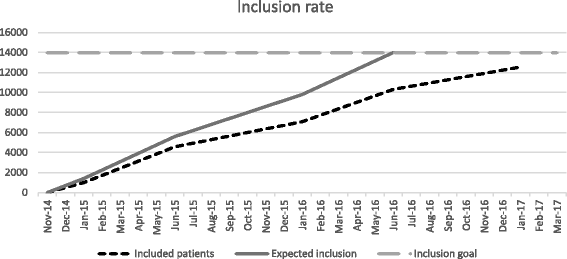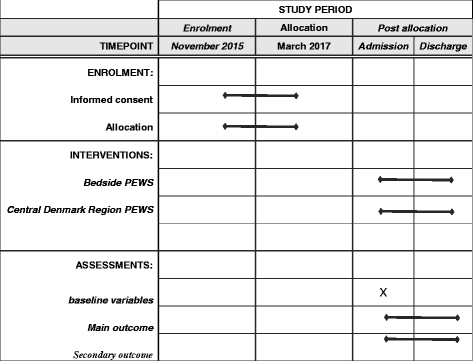A multicentre, randomised intervention study of the Paediatric Early Warning Score: study protocol for a randomised controlled trial
- PMID: 28595614
- PMCID: PMC5465452
- DOI: 10.1186/s13063-017-2011-7
A multicentre, randomised intervention study of the Paediatric Early Warning Score: study protocol for a randomised controlled trial
Abstract
Background: Patients' evolving critical illness can be predicted and prevented. However, failure to identify the signs of critical illness and subsequent lack of appropriate action for patients developing acute and critical illness remain a problem. Challenges in assessing whether a child is critically ill may be due to children's often uncharacteristic symptoms of serious illness. Children may seem relatively unaffected until shortly before circulatory and respiratory failure and cardiac arrest. The Bedside Paediatric Early Warning Score has been validated in a large multinational study and is used in two regions in Denmark. However, healthcare professionals experience difficulties in relation to measuring blood pressure and to the lack of assessment of children's level of consciousness. In addition, is it noteworthy that in 23,288-hour studies, all seven items of the Bedside Paediatric Early Warning Score were recorded in only 5.1% of patients. This trial aims to compare two Paediatric Early Warning Score (PEWS) models to identify the better model for identifying acutely and critically ill children. The hypothesis is that the Central Denmark Region PEWS model is superior to the Bedside PEWS in terms of reducing unplanned transfers to intensive care or transfers from regional hospitals to the university hospital among already hospitalised children.
Methods/design: This is a multicentre, randomised, controlled clinical trial where children are allocated to one of two different PEWS models. The study involves all paediatric departments and one emergency department in the Central Denmark Region. The primary outcome is unplanned transfer to the paediatric intensive care unit or transfer from regional hospitals to the university hospital. Based on preliminary data, 14,000 children should be included to gain a power of 80% (with a 5% significance level) and to detect a clinically significant difference of 30% of unplanned transfers to intensive care or from regional hospitals to the paediatric department at the university department. A safety interim analysis will be performed after inclusion of 7000 patients.
Discussion: This is the first randomised trial to investigate two different PEWS models. This study demonstrates the safety and effectiveness of a new PEWS model and contributes to knowledge of hospitalised children's clinical deterioration.
Trial registration: ClinicalTrials.gov, NCT02433327 . Registered on 27 April 2015.
Keywords: Intensive care unit; Paediatric Early Warning Score; Paediatrics; Randomised controlled trial.
Figures
Similar articles
-
Comparison of Two Pediatric Early Warning Systems: A Randomized Trial.J Pediatr Nurs. 2019 Jan-Feb;44:e58-e65. doi: 10.1016/j.pedn.2018.11.001. Epub 2018 Nov 22. J Pediatr Nurs. 2019. PMID: 30471827 Clinical Trial.
-
Multicentre validation of the bedside paediatric early warning system score: a severity of illness score to detect evolving critical illness in hospitalised children.Crit Care. 2011 Aug 3;15(4):R184. doi: 10.1186/cc10337. Crit Care. 2011. PMID: 21812993 Free PMC article.
-
Validation of the Children's Hospital Early Warning System for Critical Deterioration Recognition.J Pediatr Nurs. 2017 Jan-Feb;32:52-58. doi: 10.1016/j.pedn.2016.10.005. Epub 2016 Nov 5. J Pediatr Nurs. 2017. PMID: 27823915
-
Early warning scores in paediatrics: an overview.Arch Dis Child. 2019 Apr;104(4):395-399. doi: 10.1136/archdischild-2018-314807. Epub 2018 Nov 9. Arch Dis Child. 2019. PMID: 30413488 Review.
-
Validity and effectiveness of paediatric early warning systems and track and trigger tools for identifying and reducing clinical deterioration in hospitalised children: a systematic review.BMJ Open. 2019 May 5;9(5):e022105. doi: 10.1136/bmjopen-2018-022105. BMJ Open. 2019. PMID: 31061010 Free PMC article.
Cited by
-
Exploring the potential impact of adding upper limit single trigger MET thresholds to a paediatric early warning scoring tool at a tertiary children's hospital: a retrospective review.Front Pediatr. 2024 Jul 5;12:1378637. doi: 10.3389/fped.2024.1378637. eCollection 2024. Front Pediatr. 2024. PMID: 39035465 Free PMC article.
References
-
- McGaughey J, Aldernice F, Fowler R, Kapila A, Mayhew A, Moutray M. Outreach and Early Warning Systems (EWS) for the prevention of intensive care admission and death of critically ill adult patients on general hospital wards. Cochrane Database Syst Rev. 2007;3:1. - PubMed
-
- Duncan H. The paediatric early warning score. British J Intensive Care. 2007;17:133–9.
-
- Nygaard U, Schmiegelow K. Pædiatri - En illustreret lærebog [Paediatrics - an illustrated textbook] 1. Copenhagen: Fadl’s Forlag; 2010. Akut pædiatri [Emergency paediatrics] pp. 121–36.
-
- Lundstrøm K. Det akut syge barn [The critically ill child] In: Antonsen K, Callesen T, editors. Den akutte patient [The critically ill patient] Copenhagen: Munksgaard; 2010. pp. 353–76.
Publication types
MeSH terms
Associated data
LinkOut - more resources
Full Text Sources
Other Literature Sources
Medical
Miscellaneous



